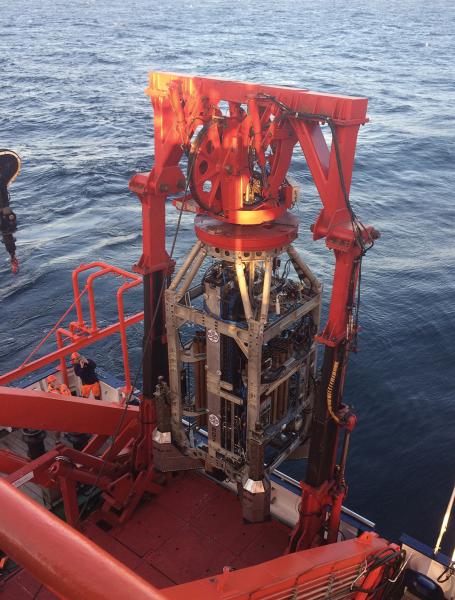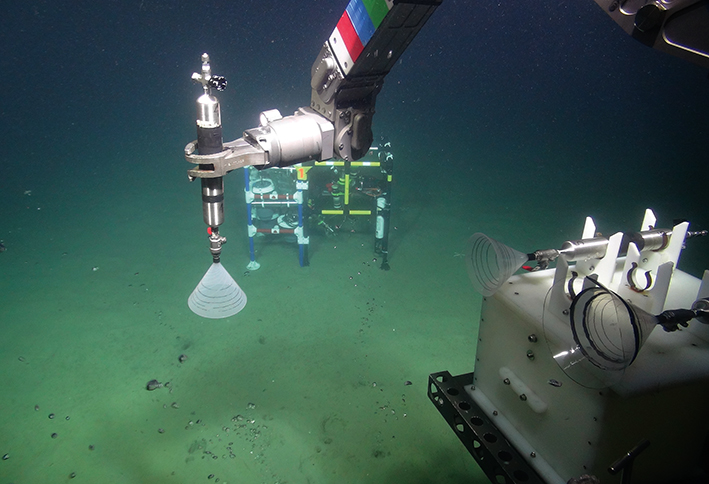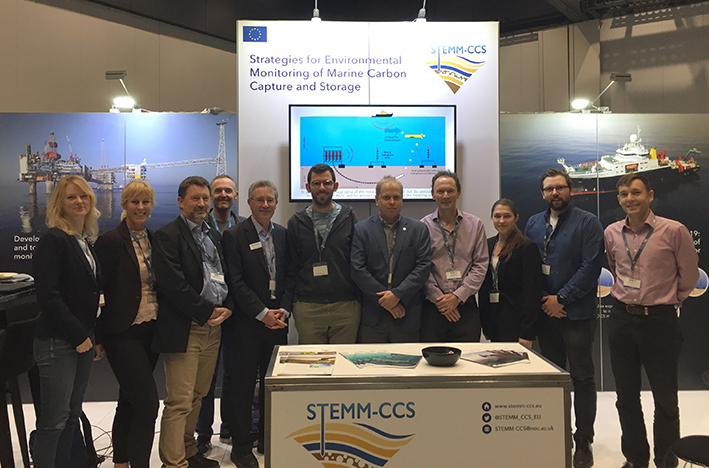The Strategies for Environmental Monitoring of Marine Carbon Capture and Storage (STEMM-CCS) project (2016-2020) was conceived to address the knowledge and capability gaps in approaches, methodologies and technology required for the effective environmental monitoring of offshore CCS storage sites. Funded under the European Union’s Horizon 2020 programme, a multidisciplinary team of researchers from 13 institutions across Europe worked in collaboration with industrial partner Shell to develop a set of tools, techniques and methods to enhance our understanding of CCS in the marine environment. The key project objectives were:
- Develop methods for assessing the ability of CO2 to permeate through the overlying seafloor sediments at offshore CCS sites, in terms of both the natural system and where CO2 has been artificially introduced.
- Build on best practice from previous research to develop robust methodology for establishing environmental and ecological baselines under ‘real life’ conditions.
- Develop cost-effective tools to identify, detect and quantify CO2 leakage from a sub-seafloor CCS reservoir.
- Assess the suitability of artificial and natural chemical tracers for the detection, quantification and mapping of escaped CO2 in the marine environment.
- Model and assess the local, regional and wider impacts of different reservoir CO2 leak scenarios and provide decision support tools for monitoring, mitigation and remediation action.
- Deliver documented best practice for selection and operation of offshore CCS sites and to transfer knowledge to industrial and regulatory stakeholders through education and training programmes.
- Share knowledge and project results, and thus increase confidence in the physical security of CCS.
STEMM-CCS combined a unique set of field experiments alongside laboratory work and mathematical modelling. Over the course of four years, researchers used the results of eight offshore expeditions totalling more than 6 months’ time at sea to identify new cost-effective ways to establish environmental and ecological baselines, advance understanding of how CO2 can move through the subsurface, and develop new techniques for the efficient and accurate detection of any CO2 escape. A key achievement is the development and enhancement of sensing technologies (chemical, optical and sonar), many of which have applications beyond the CCS arena.
The STEMM-CCS controlled release experiment
The keystone of STEMM-CCS was a novel experiment to simulate a sub-seafloor CO2 leak under real-life conditions in the North Sea. Over a period of two weeks in spring 2019, CO2 gas - augmented with inert chemical tracers - was injected into seafloor sediments at a carefully chosen experimental site near Shell’s Goldeneye complex (a proposed CCS storage site), located approximately 100 km north-east of Peterhead. The consequences of this CO2 release were carefully monitored by a sophisticated array of chemical sensors, acoustic devices, visual observations and seismic surveys operated by scientists aboard research vessels RRS James Cook and RV Poseidon.
The use of two research vessels was critical to the experiment's success. Whilst the main CO2 release experiment was executed and monitored in the near-field by RRS James Cook, the German vessel RV Poseidon carried out parallel water column surveys in the far-field in order to determine the lateral spread of CO2 away from the release site.
Preparations for this experiment took three years, not only in the development of new technology capable of detecting the smallest changes in marine conditions, but also in establishing a robust and reliable environmental baseline against which to monitor for CO2 emissions during the experiment. This involved detailed bathymetric mapping of the experimental area, continuous monitoring of environmental conditions via deployment of seafloor landers, extensive water column and seafloor sediment sampling, and benthic ecology surveys. These in situ measurements were supported by the development of a comprehensive regional model to predict short-term seasonal and spatial changes in baseline conditions.
Animation showing the planned controlled release experiment in the North Sea. CO2 gas will be released from a sub-seabed source, and its pathway through the seafloor sediments and into the water column tracked, monitored and quantified by a range of novel techniques and instruments, including passive and active sonar and chemical sensors mounted on the research vessel, underwater moorings and Autonomous Underwater Vehicles.
The controlled release experiment represented an enormous research effort - both at sea during the experiment and in the years of preparation leading up to it. The sections below highlight some of the engineering challenges that were overcome to make the experiment happen, and the scientific results that followed. The success of the experiment is testament to the teamwork and dedication of all the scientists, engineers and technicians involved.
To read the full account of the experiment and scientific results from STEMM-CCS please download our Research Highlights publication
The project’s work was structured around seven work packages, described in more detail in the sections below.
WP1 coordinated and developed the technical logistics to support and deliver the STEMM-CCS controlled release experiment in the North Sea. This included the development of the major equipment necessary to produce the controlled release of CO2: the baseline lander necessary to monitor background environmental conditions, the seafloor drill rig used to emplace the gas pipe, and the CO2 injection system to deliver CO2 gas mixed with tightly-controlled concentrations of tracer gases from a bespoke gas storage unit on the seabed to the injection site. These presented enormous engineering and logistical challenges and required innovative thinking and novel approaches to overcome the challenges of working in the dynamic conditions of the North Sea.
Through development of novel pipe placement and gas storage and handling equipment, the STEMM-CCS engineering team were able to successfully produce a controlled sub-seafloor CO2 release event. This work was vital in enabling the subsequent CO2 monitoring experiment.

WP1 objectives:
- Coordinate the production, delivery and deployment of equipment to the demonstration site
- Coordinate the management of the demonstration site
- Design, develop, manufacture and deploy a seabed drill and the CO2 delivery system to enable release of CO2 at < 5m beneath the sediment-water interface
- Deliver a current recording mooring and integrate sensors and functionality into the seabed lander
Efficient and accurate detection of CO2 leakage from CCS sites is critically dependent on having detailed and reliable knowledge of the natural environmental and ecological baselines around the storage site, so that deviations from “normal” conditions can be quickly detected and traced.
Establishing a baseline at an offshore storage site is a hugely complex and potentially costly exercise, requiring detailed observation and measurement of a wide range of parameters that encompass the physical, biological and chemical characteristics of seawater and the seafloor environment. Understanding the degree of variability in these characteristics over different spatial and temporal scales (episodic, seasonal, annual, decadal) is crucial for the effective and safe monitoring of CCS operations.
WP2 used observational, analytical and modelling techniques to map geomorphology and biological community structure; quantified the spatio-temporal variability of key chemical parameters in both water column and sediments; developed indices for biological community composition and health, and provided estimates of the existing stressors (e.g. trawling, pollution) on the marine environment. All these inputs were used to establish a sound baseline for the STEMM-CCS experimental site in the North Sea. Models were used to deliver comprehensive fields of physical and chemical properties, enabling predictions and projections of future baseline conditions against which regulators and operators can plan and future-proof environmental modelling.
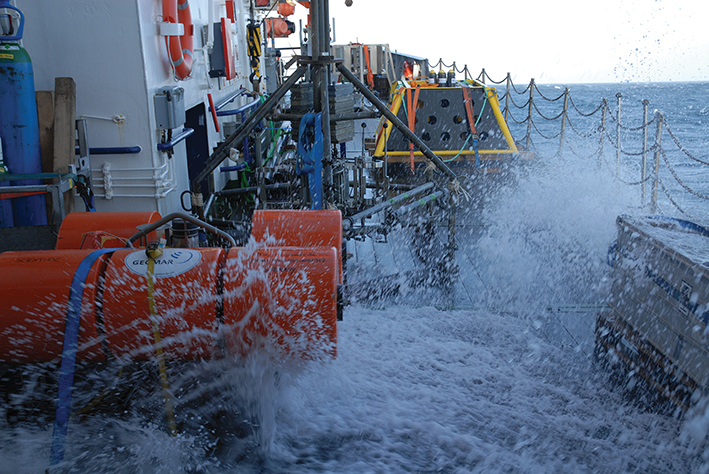
By combining existing information with a suite of newly gathered data and advanced numerical modelling, STEMM-CCS has constructed a comprehensive morphological, physico-geochemical and ecological description of the seabed above the Goldeneye storage complex. This information has been synthesised to create a comprehensive report and a seabed habitat map that also includes major human pressures such as fishing. Such documents are vital for determining the areas of seabed that potentially have the greatest sensitivity to CO2 leakage, and therefore identify those areas around which to focus environmental monitoring.
WP2 Objectives:
- Design and implement an effective environmental baseline survey at the STEMM-CCS experimental site
- Identify appropriate biological and chemical indices of impact, suitable for industrial-scale application above CCS sites
- Use modelling approaches to extend spatially and temporally limited field observation data to support a comprehensive environmental baseline
The location and likely intensity of CO2 leakage from a CCS site depend crucially on the distribution, orientation and permeability of fluid pathways in the subsurface. Sub-seafloor geological structures known as chimneys or pipe structures can be up to 500m wide and commonly occur in sedimentary basins such as the North Sea. Thought to have formed as a result of fluid migration and hydrofracturing, they present potential leakage pathways from a storage complex to the seabed and therefore require careful investigation.
STEMM-CCS used new 3D seismic and sediment imaging techniques alongside direct sampling to investigate fluid pathways in seafloor sediments. A comprehensive geophysical investigation of the pipe structure below Scanner Pockmark in the North Sea yielded important data on its permeability characteristics. Combined with direct sampling of fossil chimney structures on land, this enabled numerical models to be developed that give quantitative predictions of the efficiency of fluid flow through such structures. Permeability created by fracture networks in subsurface sediments were assessed via borehole sampling, geophysical seafloor imaging techniques and cutting-edge 4D seismic technology. These datasets were combined to form the basis for a numerical modelling study of overall fluid migration patterns and expected volumes, which demonstrated that CO2 can migrate much faster through such a structure than through the undisturbed host rock around it. However, apart from showing that pipe structures can transgress across different lithologies, the simulations also revealed the large variety of pipe structures, both in terms of size and formation mechanism. This clearly documents the demand for further studies of pipe structures in a range of sedimentary basins to put the findings on a more robust statistical footing.
These results will inform the design of a state-of-the-art cost-effective geophysical survey of the near-surface geology at the Goldeneye site in order to assess the potential for CO2 escape and to identify priority locations for monitoring.
WP3 Objectives:
- Determine the efficiency of leakage pathways for CO2 transfer
- Determine the CO2 permeability of chimney structures
- Determine how long chimney structures remain open for CO2 transfer
- Determine the physical properties of chimney structures
The ability to efficiently and accurately detect, trace and quantify CO2 leakage from storage reservoirs is critical for ensuring the safe operation of CCS in the marine environment. STEMM-CCS set out to determine the most viable and effective methods of detecting any escape, focusing on both the physical expression of CO2 as gas in seafloor sediments and the water column, and the chemical dynamics of CO2 in the dissolved phase.
New sensors and detection techniques developed during the project were tested during the controlled release experiment. The most visually obvious evidence of CO2 escape - bubbles - were monitored using passive sonar techniques alongside visual surveys to detect, quantify and trace bubble streams in the water column. Other indicators of potential CO2 escape include displacement of natural fluids and gases from the surrounding sediments, which can be detected against expected background levels established during baseline assessment. Such seepages are likely to precede any CO2 escape, and can therefore act as an early warning of reservoir integrity breach.
Artificial tracers have been successfully used in land-based CCS projects but until now have not been fully tested for use in marine storage systems. A range of chemically and isotopically distinct substances were added to the CO2 in the STEMM-CCS controlled release experiment. This allowed us to assess their suitability as sensitive tracers of gas movement through the marine environment, to quantify the volume and rate of release, and to investigate how the CO2 interacts with the sediments.
All methodologies tested during the controlled release experiment were capable of detecting the leakage of injected CO2, but only some were capable of detecting leakage at the lowest injection rates, or at distances of more than a metre or so above the seabed CO2 seeps. Not all techniques were capable of quantifying the flux of CO2 that escaped across the seabed. Gas migration through the seabed sediments can be detected remotely by sub-bottom profiler imaging (Chirp), but gas escape features need to be >~5cm in diameter. While ship-based echosounders readily detect the release of gas bubbles from the seabed, bubble fluxes are best quantified using hydrophones; however, they need to be located within ~10m of the gas seeps. As concentrations of dissolved CO2 in the water column are highly variable, anomalies due to leakage are best demonstrated using stoichiometric techniques, such as the Cseep technique developed in STEMM-CCS. Suitable variables include the ratio of CO2/O2 both of which can be measured by in situ sensors with high precision. Fluxes of dissolved CO2 across the seabed are best determined by analysis of artificial tracers that can be co-injected with CO2 into the storage reservoir. Crucially, these tracers can also be used to unambiguously confirm the source of fugitive CO2 emissions in the marine environment.
It is important to recognise that the CO2 leakage rates tested by STEMM-CCS were relatively low (≤ 50 L/min). CO2 leakage from a sub-seabed CO2 storage reservoir is most likely to occur at the injection point, through faults or from abandoned exploration wells, which can be expected to have much higher gas flow rates (from ~100 L/min at abandoned wells, to ~50,000 L/min at the injection point). In these circumstances, the footprint of the CO2 anomaly in both the seabed sediments and the water column can be expected to be significantly larger, which would greatly increase the utility of many of the methodologies tested by STEMM-CCS for leakage detection.
WP4 Objectives:
- Detect, locate and quantify CO2 leakage from the controlled sub-seabed CO2 release experiment (WP1)
- Assess the utility of artificial and natural tracers of CO2 in the marine environment
- Develop effective methodologies for quantification of CO2 fluxes across the seabed and dispersion in the water column
- Develop coupled and nested model systems to assess CO2 and tracer dispersion in sediments and the water column for a range of leakage scenarios
Innovation and technology development formed the core of STEMM-CCS. From major engineering challenges to improvements in the detection of CO2 escape, the project went beyond the current state-of-the-art in crucial areas that will provide confidence in the large-scale roll-out of operationally safe and environmentally sound CO2 storage in offshore geological reservoirs. This innovation included the design and application of new techniques and strategies, as well as the development and improvement of instruments and platforms for the detection and quantification of CO2 escape.
WP5 addressed capability gaps in the instrumentation, sensors, observational systems and techniques required to reduce the cost and uncertainty in measurement of the environment at proposed and operational CCS sites. These measurements enable site characterisation and selection, baseline survey, leak detection, leak quantification, environmental impact assessment and mitigation/remediation decisions and efficacy assessment.
STEMM-CCS developed novel sensor technology that allows - for the first time - in situ characterisation of the marine carbonate system, thus enabling detection of CO2 leaks from sub-seabed CO2 storage sites. These technological advances included the design, development and demonstration of technologies:
- CO2 flux and leak measurement across the sediment-water interface, including benthic boundary layer landers for gradient flux, relaxed eddy accumulation measurements and sediment microprofilers
- Collecting baseline environmental data, including landers equipped with novel chemical sensors for characterising natural biogeochemical variability at high resolution.
In addition, novel and commercial off-the-shelf sensors were integrated with a number of platforms including landers, AUVs and ROVs, for autonomous spatial and temporal high-resolution surveys of the CO2 release site and profiling the CO2 plume. STEMM-CCS demonstrated that chemical sensor-based technologies can effectively detect and quantify CO2 leakage from the seabed even in the absence of visual evidence (i.e. bubbles).
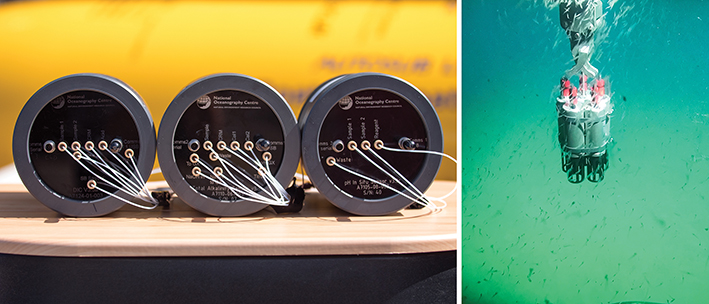
To help CCS operators assess and select an offshore, sub-seabed CO2 storage site, STEMM-CCS developed and constructed an online decision support tool which can also assist with the identification and prioritisation of appropriate techniques that could form part of an operational site monitoring programme
WP5 Objectives:
- Develop new technologies and optimise methods to locate, detect and quantify CO2 leakage
- Develop new technologies and techniques for measurement of biological and chemical parameters, including natural variability
- Reduce the cost of data collection by developing new technologies and techniques
- Assimilate measurement and model information to produce a decision support tool to guide mitigation and remediation action
- Develop automated low-cost seabed imaging and mapping technologies and techniques for baseline and impact assessments
STEMM-CCS invested significant effort in exporting knowledge and products to many international stakeholders through networking and presentations at international conferences such as GHGT-14, bilateral discussions with other CCS research teams in Australia and Japan, and ensuring project results are published in a timely manner in the scientific literature, including a special volume of the International Journal of Greenhouse Gas Control
WP6 Objectives:
- Capitalise on collaborative interactions with international research and development to maximise the impact of STEMM-CCS
- Maximise the exposure and dissemination of project outputs to an international audience of CCS stakeholders including industry, regulators, governments and researchers
WP7 hosted a series of events to share the project’s results and knowledge gained with a range of CCS stakeholders. These included two policy-focused events involving representatives from academia, industry and policymaking groups, as well as an open final meeting held in partnership with the International Energy Association Greenhouse Gas Group’s Offshore Geologic Storage Workshop which attracted 150 participants from all over the world.
In its four years of work, STEMM-CCS has invested in the development and training of young scientists across the spectrum of offshore CCS-relevant disciplines. More than 20 postgraduate (PhD) and postdoctoral researchers were directly involved in STEMM-CCS effort, and indeed they represent a critical component of the project’s work force without whom it would have been impossible to achieve such significant scientific advances. STEMM-CCS has encouraged development (at all career stages) beyond the boundaries of everyday research by providing opportunities and financial support to undertake placements in industry and elsewhere in the CCS research community. A series of training events has enabled project researchers to broaden their perspectives, learn from CCS experts outside the consortium, and strengthen their use of cross-platform tools and techniques to increase the impact of their research.
The project has also undertaken outreach and dissemination activities with local communities who may be affected by CCS operations in the North Sea, and provided a range of resources to those wanting to learn more about the environmental aspects of offshore CCS. The controlled release expedition in spring 2019 provided excellent outreach opportunities: as well as a steady social media feed and a daily blog from the ship, a series of live sessions from the ship enabled direct engagement with schoolchildren in the UK.
WP7 Objectives:
- Ensuring that accurate information about CO2 storage is available by providing clear and accessible communications designed for specific audiences
- Facilitating interaction between project scientists and stakeholders
- Establish a comprehensive training programme for the community of postgraduate and postdoctoral researchers involved in the project, and industry and regulatory stakeholders
